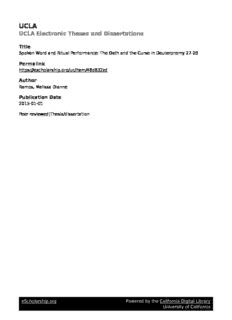
Ramos Spoken Word and Ritual Performance Dissertation Final PDF
Preview Ramos Spoken Word and Ritual Performance Dissertation Final
UCLA UCLA Electronic Theses and Dissertations Title Spoken Word and Ritual Performance: The Oath and the Curse in Deuteronomy 27-28 Permalink https://escholarship.org/uc/item/48d832zd Author Ramos, Melissa Dianne Publication Date 2015 Peer reviewed|Thesis/dissertation eScholarship.org Powered by the California Digital Library University of California UNIVERSITY OF CALIFORNIA Los Angeles Spoken Word and Ritual Performance: The Oath and the Curse in Deuteronomy 27-28 A dissertation submitted in partial satisfaction of the requirements for the degree Doctor of Philosophy in Near Eastern Languages and Cultures by Melissa Dianne Ramos 2015 © Copyright by Melissa Dianne Ramos 2015 ABSTRACT OF THE DISSERTATION Spoken Word and Ritual Performance: The Oath and the Curse in Deuteronomy 27-28 by Melissa Dianne Ramos Doctor of Philosophy in Near Eastern Languages and Cultures University of California, Los Angeles, 2015 Professor William M. Schniedewind, Chair The composition of Deut 27-28 is shaped by its ritual and performative function and by the narrative device of a script within a speech: the oral and ritual performance of the covenant ceremony by the Levites is framed within the speech-command of Moses. Studies of Deut 28 have largely focused on the textual tradition of this chapter and on its parallels with ancient near eastern treaties, and with the Succession Treaty of Esarhaddon in particular. Many studies view Deut 28 as a collection of isolated units of curse lines disconnected from the ceremonial performance of the covenant ratification ceremony detailed in Deut 27. This is due in part to the commonly held view that chapter 27 is an interpolation and a later addition to the literary unit of 12-26 and 28. However, a re-examination of comparative ancient near eastern evidence and a fresh literary analysis of 27 suggests that chapters 27-28 form a unified whole. A text-centric approach to Deut 28 has left largely unexamined the oral and ritual performance described in Deut 27. Ratification of oaths and treaties in the ancient near east was performative and entailed ii speaking words of power and performing ritual acts such as the slaughter of an animal or the ceremonial breaking of weapons. Deut 27 also furnishes instructions for the erection of an altar, ritual sacrifices, and an oral recitation of “all the words of this torah” including the blessings and curses in chapter 28. This concept of oaths and treaties as scripts is explored using the Aramaic Sefire treaty as a test case. An analysis of the curse segment of the Sefire treaty shows syntactical features typical of spoken language, suggesting that the curse portion of the written treaty was shaped by oral recitation and/or an oral tradition of formulaic curse language. The text-centric approach to studies of Deut 28 has also hindered examination of parallels between treaties and ritual and performative texts, and especially incantations. A study of contiguities between Deut 27-28 and the Neo-Assyrian incantation series Maqlû and Šurpu reveals compelling thematic, linguistic, and formological parallels. iii The dissertation of Melissa Dianne Ramos is approved. Ra’anan S. Boustan Giorgio Buccellati William M. Schniedewind, Committee Chair University of California, Los Angeles 2015 iv For Francisco הבהאב v Table of Contents Abstract of Dissertation ii-iii Acknowledgements x-xii Vita xiii-xiv Chapter One: Introduction 1 Chapter Two: The Performance of Doom in Deut 27-28 11 Chapter Three: “You Shall Write on the Stones”: Deut 27-28 as a Literary Unit 44 Chapter Four: “Thus We Have Spoken and Thus We Have Written”: The Curses of Sefire and Ritual Oath Performance 74 Chapter Five: Deut 27-28 and Maqlû and Šurpu: Making an Oath and Countering an Oath 109 Chapter Six: Conclusion 143 Bibliography 150 vi List of Tables Table 1: Comparative Table of Noun to Verb Ratios 86 Table 2: Syntactical Formula of Futility Curses in the Ancient Near East 103 Table 3: Syntactical Formula of Futility Curses in Deut 28 104 Table 4: Oath and Curse Terminology 114 Table 5: Thematic Parallels between Deut 28 and Maqlû and Šurpu 122-125 Table 6: Parallel Curse Order and Combinations in Deut 27 and Šurpu Tablet II 128 vii Abbreviations AfO Archiv für Orientforschung BASOR Bulletin of the American Schools of Oriental Research BZAW Beihefte zur Zeitschrift für alttestamentliche Wissenschaft COS The Context of Scripture. 3 Volumes. Edited by William W. Hallo. Leiden, 2003. FAT Forschungen zur Religion und Literatur des Alten und Neuen Testaments IEJ Israel Exploration Journal JANES Journal of Ancient Near Eastern Studies JAOS Journal of the American Oriental Society JBL Journal of Biblical Literature JCS Journal of Cuneiform Studies JHS Journal of Hebrew Scriptures JNES Journal of Near Eastern Studies JSOT Journal for the Study of the Old Testament JSS Journal of Semitic Studies MUSJ Mélanges de l’Université Saint-Joseph RAI Rencontre Assyriologique Internationale SAA Society for American Archaeology SBL Society of Biblical Literature STE Succession Treaty of Esarhaddon viii
Description: